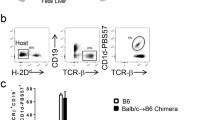Abstract
Mutational disparities derived from alleles of theH-2K andH-2D loci vary widely in their ability to induce neonatal tolerance. The more subtle mutations, such asK bm5 andK bm8, proved to be excellent tolerogens, but theK bm3 mutant (M505) turned out to be the poorest tolerogen yet studied of all H-2 alloantigens. By challenging tolerant animals with skin grafts from related mutants, it was found that expression of tolerance was highly specific. Although a minority of tolerant animals failed to discriminate between the Kb, Kbm5 and Kbm8 antigens, they never failed to discern Kb, Kbml and Kbm3 as distinctly different alloantigens.
Similar content being viewed by others
References
Bailey, D. W. and Kohn, H. I.: Inherited histocompatibility changes in progeny of irradiated and unirradiated inbred mice.Genet. Res. 6: 330–340, 1965
Billingham, R. E., Brent, L., and Medawar, P. B.: Quantitative studies on tissue transplantation immunity. III. Actively acquired tolerance.Proc. R. Soc. Lond. (Biol.) 239: 357–414, 1956
Billingham, R. E.and Silvers, W. K.: Free skin grafting in mammals.Transplantation of Tissues and Cells. Wistar Institute Press, Philadelphia, Pennsylvania 1961
Brown, J. L. and Nathenson, S. G.: Structural differences between parent and mutantH-2K glycoproteins from twoH-2K gene mutants: B6.C-H-2ba (Hzl) and B6-H-2bd (M505).J. Immunol. 118: 98–102, 1977
Brown, J. L., Nairn, R., and Nathenson, S. G.: Structural differences between the mouse H-2D products of the mutantB10.D2.M504(H-2 da) and the parental nonmutant strain B10.D2 (H-2 d)J. Immunol. 120: 726–733, 1978
Dishkant, I. P., Vedernikov, A. A., and Egorov, I. K.: Study ofH-2 mutations in mice. 3. Serological analysis of mutation M504 and its derived recombinantH-2 haplotypes.Genetika 9: 83–90, 1973
Duncan, W. R., Wakeland, E. K., and Klein, J.: Histocompatibility-2 system in wild mice. VIII. Frequencies of H-2 and Ia antigens in wild mice from Texas.Immunogenetics 9: 263–274, 1979
Egorov, I. K.: A mutation of the histocompatibility-2 locus in the mouse.Genetika 3: 136–144, 1967
Forman, J. and Klein, J.: Immunogenetic analysis ofH-2 mutations. II. Cellular immunity to theH-2 da mutation.J. Immunol. 115: 711–715, 1975a
Forman, J. and Klein, J.: Analysis ofH-2 Mutants: Evidence for multiple CML target specificities controlled by theH-2 gene.Immunogenetics 1: 469–481, 1975b
Forman, J. and Klein, J.: Immunogenetic analysis ofH-2 mutations. VI. Cross-reactivity in cell-mediated lympholysis between TNP-modified cells fromH-2 mutant strains.Immunogenetics 4: 183–193, 1977
Iványi, P. and Micková, M.: Testing of wild mice for “private” H-2 antigens. Cross reactions or nonspecific reactions?Transplantation 14: 802–804, 1972
Klein, J.: Histocompatibility-2 system in wild mice. I. Identification of five newH-2 chromosomes.Transplantation 13: 291–299, 1972
Klein, J.:Biology of the Mouse Histocompatibility-2 Complex, Springer-Verlag, New York, 1975
Klein, J.:H-2 mutations: Their genetics and effect on immune function.Adv. Immunol. 26: 55–146, 1978
Klein, J., Duncan, W. R., Wakeland, E. K., Zaleska-Rutczynska, Z., Huang, H-J., and Hsu, E.: Characterization ofH-2 haplotypes in wild mice. In H. S. Morse III (ed.):Origins of Inbred Mice, pp. 667–688 Academic Press, New York 1978
Klein, J. and Egorov, I. K.: Graft-vs-host reaction with anH-2 mutant.J. Immunol. 111: 976–979, 1973
Klein, J., Hauptfeld, M., and Hauptfeld, V.: Serological distinction of mutants B6.C-H(zl) and B6.M505 from strain C57BL/6.J. Exp. Med. 140: 1127–1132, 1974
Klein, J., Hauptfeld, M., Geib, R., and Hammerberg, C.: Immunogenetic analysis ofH-2 mutations: V. Serological analysis of mutationsH-2 da,H-2 fa, andH-2 ka.Transplantation 22: 572–582, 1976
Kohn, H. I., Klein, J., Melvold, R. W., Nathenson, S. G., Pious, D., and Shreffler, D. C.: The firstH-2 mutant workshop.Immunogenetics 7: 279–294, 1978
McKenzie, I.F.C., Morgan, G. M., Melvold, R. W., and Kohn, H. I.: Serological and complementation studies in four C57BL/6H-2 mutants.Immunogenetics 3: 241–251, 1976
McKenzie, I. F. C., Morgan, G. M., Blanden, R. V., Melvold, R., and Kohn, H.: Studies ofH-2 mutations in C57BL/6 and BALB/c mice.Transplant. Proc. 9: 551–553, 1977
Melief, C. J. M., Schwartz, R. S., Kohn, H. I., and Melvold, R. W.: Dermal histocompatibility and in vitro lymphocyte reactions of three newH-2 mutants.Immunogenetics 2: 337–348, 1975
Melief, C. J. M., van der Meulen, M., and Postma, P.: CML typing of serologically identicalH-2 mutants. Distinction of 19 specificities on the cells of four mouse strains carryingzl locus mutations and the strain of origin.Immunogenetics 5: 43–56, 1977
Melvold, R. W. and Kohn, H. I.: Eight new histocompatibility mutations associated with theH-2 complex.Immunogenetics 3: 185–191, 1976
Nathenson, S. G., Brown, J. L., Ewenstein, B. M., Nisizawa, T., Sears, D. W., and Freed, J. H.: Structural differences between parent and variant H-2K glycoproteins from mouse strains carryingH-2 gene mutations.Cold Spring Harbor Symp. Quant. Biol. 41: 343–349, 1976
Rieger, M. and Hilgert, I.: The involvement of a suppressor mechanism in neonatally induced allograft tolerance in mice.J. Immunogenetics 4: 61–67, 1977
Rychliková, M., Démant, P., and Egorov, I.: Mixed lymphocyte reaction caused by anH-2D mutation.Folia Biol. (Praha) 18: 360, 1972
Streilein, J. W. and Klein, J.: Neonatal tolerance induction across regions ofH-2 complex.J. Immunol. 119: 2147–2150, 1977
Streilein, J. W. and Klein, J.: Neonatal tolerance toK andD region alloantigens ofH-2 complex:I-J region requirements.Transplant. Proc. 11: 732–735, 1979
Zinkernagel, R. M.:H-2 compatibility requirement for virus-specific T-cell-mediated cytolysis. The H-2K structure involved is coded by a single cistron defined byH-2K b mutant mice.J. Exp. Med. 143: 437–443, 1976
Zinkernagel, R. M. and Klein, J.:H-2-associated specificity of virus-immune cytotoxic T cells fromH-2 mutant and wild-type mice: M523 (H-2K ka) and M505 (H-2K bd) do, M504 (H-2D da) and M506 (H-2K fa) do not crossreact with wild-typeH-2K orH-2D.Immunogenetics 4: 581–590, 1977
Author information
Authors and Affiliations
Rights and permissions
About this article
Cite this article
Streilein, J.W., Klein, J. Neonatal tolerance induction acrossH-2 mutational disparity: Induction and specificity of tolerance. Immunogenetics 10, 113–123 (1980). https://doi.org/10.1007/BF01561560
Received:
Issue Date:
DOI: https://doi.org/10.1007/BF01561560




